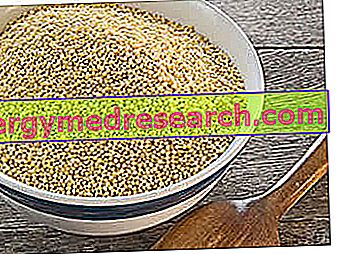Generality
The hornet sting is rather painful and, in sensitive and predisposed subjects, can lead to unpleasant, sometimes severe, consequences.

The risk of incurring a hornet sting is higher during the warm months. With the arrival of summer, in fact, increases the desire to spend time outdoors and surrounded by nature; on the other hand, it also increases the risk of hitting the bites of various insects, such as mosquitoes, horseflies, bees, wasps and hornets.
The hornet is a large insect belonging to the genus Vespa and, as such, equipped with a stinging apparatus connected to particular venom-secreting glands . The bite of a hornet is very painful precisely because of the inoculation of the aforementioned poison which, in hypersensitive individuals, causes more or less important allergic reactions.
What is the Bumblebee?
Main characteristics of the Bumblebee
The hornet belongs to the class of insects (Insecta), order of the hymenopterans (Hymenoptera), genus Vespa, crabro species. Also known as European hornet or red cravunar, this insect is the largest European vespid. Not surprisingly, for many people, the bite of a hornet is the most painful of hymenoptera bites.

It is an omnivorous insect that feeds on other insects, as well as plant material, sometimes, being particularly harmful for agriculture and, in particular, for the cultivation of fruits such as grapes and apples.
The hornet's nest - inside which the queen lives - is built by female workers (sterile female specimens) using vegetable fibers derived from various types of wood. The nest - which can be built on trunks, branches or inside cracks in the walls - is characterized by a typical paper aspect .
The bumblebee generally tends to avoid man, or at least to maintain an indifferent behavior towards him. However, if you are near the nest, it can be particularly aggressive and attack. In light of what has just been said, therefore, it is possible to affirm that the hornet sting is used by this insect as a defense mechanism .
Unlike bees, the hornet has a smooth sting that hardly remains embedded in the skin of the victim. Thanks to this characteristic, the insect in question can repeatedly bite the man, for this reason, after being stung, it is good to move away from the area where you are.
Did you know that ...
Due to the danger of hornet sting and due to the potential damage that this insect can cause to crops, the nests it builds are frequently destroyed and the contained specimens killed. Because of this behavior - aimed at safeguarding human health, agriculture and economic interest, but certainly not biodiversity - in some European countries, the hornet is considered an endangered species and is therefore protected.
Features
Characteristics of the Poison and of the Bumblebee Sting
As mentioned, the hornets have a smooth, retractable sting at the apex of the abdomen, directly connected to poison glands . The sting hardly remains stuck in the skin of the "victim" following the first puncture and this allows the insect to attack repeatedly, increasing the dose of injected poison.
The venom of the bumblebee - as well as that of other wasps and like that of bees - is made up of numerous substances of a proteinic nature and not, responsible for all the reactions that occur after the bite. Generally speaking, it is possible to state that hornet venom consists of two main categories of substances:
- Toxic components : they are substances that - once injected through the sting - give rise to pain and strong vasodilation ; the latter is directly responsible for the typical skin manifestations of hornet sting (see next paragraph). Examples of toxic substances of this type are the biogenic amines contained in the poison, such as histamine.
- Components with allergenic activity : these substances give rise to allergic reactions in sensitive individuals. The allergens injected through the bite of a hornet are able to activate a response from the immune system with the consequent release of mediators involved in the development of the allergic reaction.
Despite the substances contained in it, usually, the hornet venom is not lethal to humans, since the concentrations injected through the sting are reduced. However, in the most severe cases of hypersensitivity, it is possible to develop very severe allergic reactions, potentially lethal if not treated immediately (anaphylactic shock).
Curiosity
In 2016, a "killer hornet" alarm occurred in Italy. In truth, this name which undoubtedly inspires fear has nothing to do with the Vespa crabro hornet. The killer hornet that frightened the country, in fact, is a particular type of wasp originally from China considered an alien species in our peninsula. This insect - whose scientific name is Vespa velutina - has earned the name of "killer hornet" because of its aggressiveness, its potentially lethal stings for sensitive individuals and because of its appearance, very similar to that of the typical European hornet of the Bel Paese. Not surprisingly, this wasp is also commonly referred to as the "Asian hornet".
Symptoms
Symptoms induced by the hornet sting
The symptoms induced by the hornet bite can be different depending on the individual being attacked by the insect. In this regard, it is possible to distinguish a different symptomatology in normosensitive individuals and in hypersensitive individuals.
Usually, in non-allergic individuals, the hornet sting is manifested by an erythematous-edematous skin reaction (red, swollen ointment) accompanied by an acute pain that tends to resolve within a relatively short time.
In individuals that exhibit hypersensitivity to insect venom, however, the cutaneous reaction to bumble bee sting may be more severe, giving rise to a more pronounced swelling (local reactions with a diameter greater than 5-10 cm) compared to what occurs in normosensitive individuals. Even the perceived pain is generally more intense and tends to gradually increase rather than shrink.
In more serious cases it is also possible to experience a systemic allergic reaction - more or less severe - that involves different body areas giving rise to symptoms, such as:
- Angioedema and generalized swelling;
- Generalized urticaria;
- Palpitations and increase in heart rate;
- Slight fever;
- Fatigue.
When the generalized swelling induced by the reaction to the bumble bee affects the throat and the airways, there is a consequent difficulty in breathing which requires immediate intervention.
Finally, in the most serious cases, it is possible to run into anaphylactic shock, characterized by:
- Dizziness;
- Severe malaise;
- Strong reduction in blood pressure;
- Tachycardia;
- bronchospasm;
- Cyanosis and feeling of suffocation;
- Loss of consciousness;
- Cardiovascular collapse.
Should any of the above symptoms appear following a hornet bite, it is necessary to immediately contact the medical help and your doctor.
Treatment
First intervention in case of hornet sting
In the case of hornet stings, it is very important to intervene quickly. As stated in the previous chapters, the sting of the hornet is hardly stuck in the skin, however, should this occur, it is necessary to proceed immediately with its extraction. To do this it would be good to use an instrument with a thinly sterilized edge (even with a flame if you were outdoors and without other instruments).
After the eventual extraction of the sting, or immediately after the bite of a hornet in the case in which the sting had not been stuck in the skin of the victim, it would be good:
- Wash the affected area of skin with soap and water and then proceed with skin disinfection .
- To reduce pain and try, as far as possible, to attenuate the inflammatory response triggered by the bumblebee sting, place ice on the lesion, or expose the affected area to a jet of cold water .
- Use on the lesion based on corticosteroid drugs (for example, hydrocortisone) specially formulated to counteract the inflammatory processes resulting from insect bites and stings (for example, Foille Insetti®). These ointments are generally freely available in pharmacies or pharmacies without a medical prescription (they are, in fact, over-the-counter medications).
If, despite the aforementioned interventions, swelling and pain persist - or worse, increase - the intervention of the doctor is necessary who can prescribe the administration of other corticosteroid drugs and / or antihistamines .
The intervention of health personnel is also fundamental if symptoms typical of systemic allergic reactions occur or, in the most serious cases, when symptoms attributable to a potential anaphylactic shock occur. In such situations, it is necessary to immediately contact 118, since the timeliness of intervention is decisive for the patient's salvation. Pending the arrival of relief, the hypersensitive individual from the hornet must remain in a relaxed position ; if unconscious, it should be placed in the lateral safety position .
Treatment of Individuals with Known Allergy to Hornet Venom
Individuals with a known allergy to poison inoculated with a hornet sting are normally provided by their doctor with an emergency medicine consisting of an auto-injector containing adrenaline . The allergic patient should always carry the medicine with him, following all the instructions that will be provided by the doctor.
Prevention
How to prevent the hornet bite
Given the potential risks associated with the bite of a hornet and the venom it injected, prevention is essential. Although it is not always possible to avoid the encounter with these insects, in order to prevent a possible hornet sting, it may be useful to adopt the following precautions:
- Avoid places where hornet nests are notoriously present; in fact, these insects can become particularly aggressive if they are near their nest.
- Avoid standing near trees or other vegetation in which there are hornets (for example, near fruit trees, vines, etc.).
- Avoid walking barefoot on the grass.
- If it is necessary to stay in an area frequented by hornets (for example, for work reasons: harvest, fruit picking, pruning, etc.), wear shirts / sweaters and long, close-fitting trousers and closed shoes, so as to protect the most of the body.
- During picnics and meals eaten outdoors or in the garden, avoid leaving food and drink residues that could catch the attention of any hornets.
- Avoid wearing clothes that are too loose (below which the hornets could infiltrate) and avoid perfumes (in particular, sweet ones) that could attract the attention of insects.
Furthermore, if you notice the presence of one or more hornets, it is good to try to get away as quickly as possible, avoiding sudden movements (for example, waving your arms to avoid them) and avoiding attempts to crush them (a similar behavior, in fact, could further alert the insect making it more aggressive).
Since this insect rarely leaves the sting stuck in the skin and can sting the unfortunate "victim" several times, even in the case of a hornet bite it is necessary to immediately leave the area where the event occurred, naturally, by adopting all cautions mentioned above.



